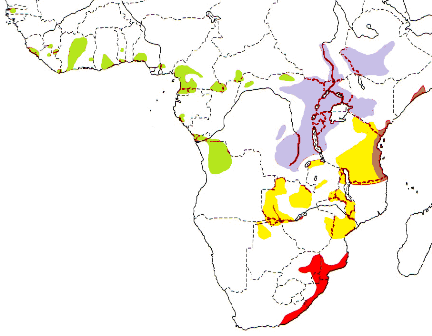Weaver species
Choose different species from drop-down list and press 'Go' button. See Full species list.Thick-billed Weaver Amblyospiza albifrons
IUCN: Least concern Discovery: 036Categories: wetland, fruit, frogs, nectar, pest, Nest use, Amblyospiza,
News items about species
Discovery

figure from Swainson 1838 
figure from Smith 1840 
figure from Smith 1840 
distribution, type locality circled IntroductionThe Thick-billed Weaver was formally described by Nicholas Aylward Vigors, an Irish zoologist and politician. Vigors was a co-founder of the Zoological Society of London in 1826, and its first secretary until 1833.The Thick-billed Weaver specimen was presented to the Zoological Society of London by Henry Ellis, an English librarian at the British Museum. It is not known from whom Ellis obtained these specimens. Vigors described nine new species from the Ellis collection and the specimens were all believed to have come from Algoa Bay and surroundings in the Eastern Cape. Two species, however, the Purple-crested Turaco Tauraco porphyreolophus and the Spotted Thrush Zoothera guttata, have their southern limits further north in the Transkei (and may have come from Durban), but the rest of the specimens probably did originate from the Algoa Bay area. The first illustration of a Thick-billed Weaver is in Swainson (1838), showing a line drawing of the very heavy bill of a male. A few years after this species was first described, Andrew Smith found this species in 2 places: in the Eastern Cape forests (probably not too far from Grahamstown, as Smith was based there in his early years in South Africa) and around Durban (Port Natal) in 1832. Smith commisioned the first colour illustrations of the The Thick-billed Weaver - these were published as 2 plates in Smith (1840), and painted by George Henry Ford. Scientific citationPyrrhula albifrons Vigors 1831; Proc. Zool. Soc. London, p.92 1831 Algoa Bay, eastern Cape.Meaning of namesalbifrons Latin: albus, white; frons, the forehead, brow.First English nameWhite-fronted Grosbeak (Gurney 1860).Alternate namesAbyssinian Grosbeak Weaver, Angola Grosbeak Weaver, Ashanti White-fronted Grosbeak, Black Swamp Weaver, Cameroon Grosbeak Weaver, Cavort chewer, East Coast Grosbeak Weaver, Grosbeak Weaver, Hawfinch Weaver, Kenya Grosbeak Weaver, The white-headed Coryphegnathus, White Nile Grosbeak Weaver, White-fronted Grosbeak, White-fronted Weaver.CollectorUknown.Date collectedBefore 1831.Locality collectedAlgoa Bay.Type specimensThe type specimen is not in the British Museum (Warren 1971), and is thus probably lost. |
The above is based on Weaver Wednesday 2, a weekly series about the discovery of each weaver species.
This species text first appeared as
Weaver Wednesday [153] - Discovery [36]: Thick-billed Weaver on 2015-05-20
1. Basic biology
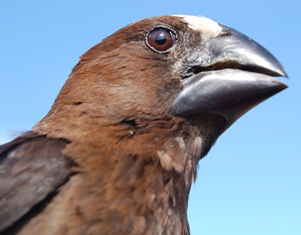

Identification. The Thick-billed Weaver Amblyospiza albifrons is in a monotypic genus (only one species in the genus), namely Amblyospiza, this name meaning "blunt, finch", referring to its amazingly heavy bill. The male has a black bill, white forehead (photo left) and conspicuous white patches in its wings; the rest of its plumage varies racially, from chestnut to black. The sexes are dissimilar, and the female has a yellow bill, brown upperparts, and underparts white heavily striped with sepia. The juvenile resembles the female, but the bill is yellowish; immature males need 2 years to attain adult plumage. Distribution.
The Thick-billed Weaver is widespread in sub-Saharan Africa and has five subspecies.
This species is expanding its range, especially in the provinces around Gauteng in South Africa (see here). Habitat. The Thick-billed Weaver inhabits wetlands when breeding and forest edges when not breeding, and shows some local movements. It is a fairly common species locally. Food.
The Thick-billed Weaver feeds on insects (including termites), berries and fruit, and hard-shelled seeds; also sunflower seeds. An adult in Kenya ate a small frog, and aquatic snails have been recorded in its diet.
Breeding. The nest of the Thick-billed Weaver is distinctive. It is compact, woven with thin strips of reeds, slung between upright stems of reeds. The nest is globe-shaped with a side entrance near the top. The fine material used lets a nest look neat, but actually the weave is very primitive. Initially the entrance is large, and reduced to a narrow opening if used for breeding. Colonies may be small with one male, or larger with several males, in a reed patch. This species is polygynous, the male attempting to attract several females. The mean clutch size 3 eggs, and the eggs are white to pink, spotted with red, purple and brown. Incubation is by the female, with long incubation spells of 33 minutes (and 12 minutes off the nest). The chicks are fed by the female (by regurgitation), and sometimes the male also feeds. Nest predators include the White-browed Coucal Centropus superciliosus, House Crow Corvus splendens, and Nile monitor Varanus niloticus. Old nests may be taken over by climbing mice, and used for breeding by the Zebra Waxbill Amandava subflava or Brown Firefinch Lagonosticta nitidula. |
The above is based on Weaver Wednesday, a weekly series about weaver species.
This species text first appeared as
Weaver Wednesday [8]: Thick-billed Weaver on 2012-08-08
2. Breeding facts
| Pair bond Polygynous, male with up to six females, three nesting simultmeously on teritory; also single nests and apparently monogamous pairs in areas of low density Breeding season May-Nov in Cameroon, Jul-Oct in Central African Republic, Nov in Sudan, and May-Jun and Aug-Sept in Ethiopia; in DRCongo, Jan-Mar in Katanga, Jun-Nov in Ituri and Jan in Itombwe; all months except Nov-Dec (peak Apr-Jun) in Uganda; in Kenya Apr-Oct on coast and all months except Sept-Oct (peak Mar-Jun) inland; Mar-Apr in Rwanda, Dec-Feb and Apr-May in Tanzania, and Dec-Mar in Mozambique, Angola, Zambia and Malawi; Jan-Feb and Apr in Botswana, and Nov-Mar in Zimbabwe; in South Africa, Nov-Mar inland and Sept-Mar in coastal regions Nest site attached, 1-3 m above ground or water, to bulrushes , papyrus (Cyperus papyrus) or reeds (Phragmites) and sedges, usually over water, also in tall elephant grass (Pennisetum purpureum) Nest building built by male, female lining cup Colony size Often in small colonies; more than 100 nests in one South African colony Clutch size mean 3 eggs (Malawi, South Africa) Egg colour white to pink, spotted with red, purple and brown Egg size average size of 165 in S Africa 23.6 x 16.2 mm Incubation by female, in mean spells of 33 minutes (mean 12.5 minutes off nest), period 14-16 days Chicks and nestling period chicks fed by female (by regugitation), occasionally by male, nestling period 18-20 days |
Breeding information based on Handbook of the Birds of the World, Vol. 15.
3. Photos of Weaver Nests
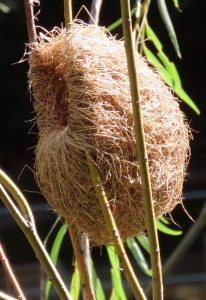 Vm 31023 | 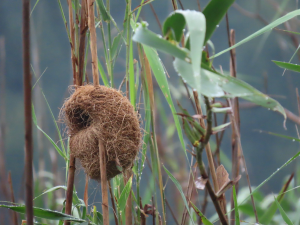 Vm 30757 | 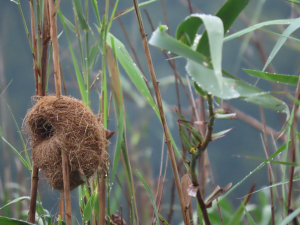 Vm 30703 | 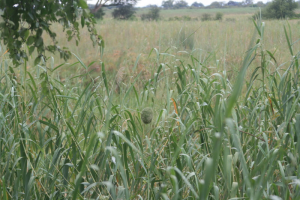 Vm 30688 | 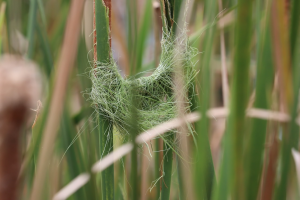 Vm 30674 | 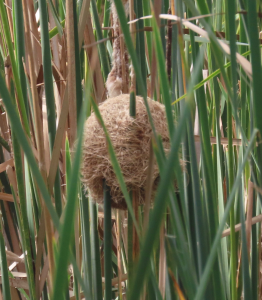 Vm 30545 |
Thumb-nails of most recent PHOWN records - click on one to see its full record
See all PHOWN records for this species here.
PHOWN (Photos of Weaver Nests) provides valuable info on breeding distribution and colony sizes of weavers.
You can contribute by registering and submitting photos at Virtual Museum webpage.
4. Breeding distribution
Google map showing distribution (For species with small ranges you need to zoom in at the correct area to see the range):
yellow blob - range of weaver species; read more about this here.
![]() - PHOWN records with photos
- PHOWN records with photos
![]() - PHOWN records with no photos (Nest Record Cards, other records)
- PHOWN records with no photos (Nest Record Cards, other records)
![]() - Birdpix records
- Birdpix records
![]() - comments on out of range records, or interesting records
- comments on out of range records, or interesting records
![]() - type locality
- type locality
CLICK on the marker on the map to see individual record details.
5. Range changes

Red, orange and yellow = cells with very large, large, and small relative decreases Blue, dark green and light green = cells with very large, large and small relative increases. Cells = quarter-degree grid cells; Only cells with at least 4 checklists in both SABAP1&2 shown. All cells had this species recorded in SABAP1 or in SABAP2 or in both (more about interpretation at Biodiversity Observations 7.62: 1-13).
Range changes in SA
The points below match the points on the map above. Areas with very large increases include:
Areas with very large decreases:
Range changes elsewhereZimbabwe: increase in Harare, expanding from east (Baker 2011b). | |||||||||||||||||||||||||||||||||||
The above is based on Weaver Wednesday 3, a weekly series about range changes in South African weaver species.
This species text first appeared as
Weaver Wednesday 3 [252] - Range changes [15]: Thick-billed Weaver on 2017-04-12











